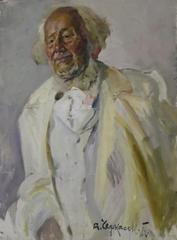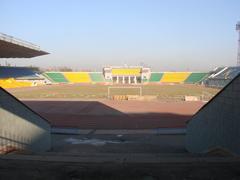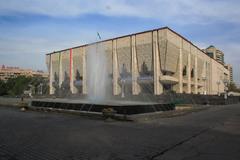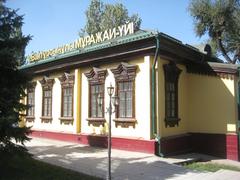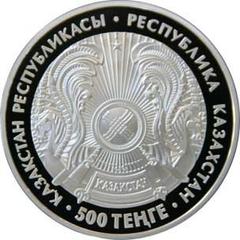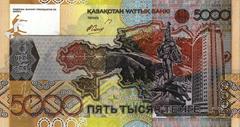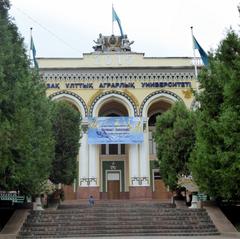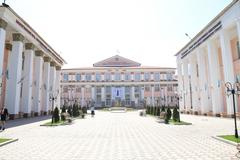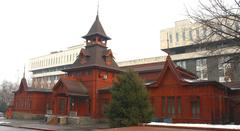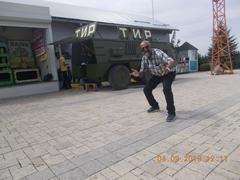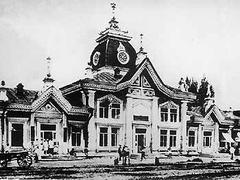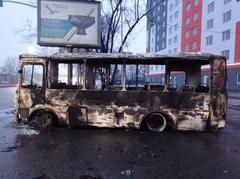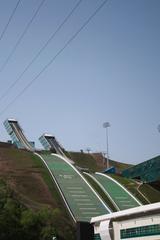
Palace of the Republic Almaty: Visiting Hours, Tickets, and Historical Significance
Date: 03/07/2025
Introduction
The Palace of the Republic in Almaty, Kazakhstan, is one of the city’s most iconic landmarks, seamlessly blending Soviet-era modernist architecture with Kazakh national motifs. Since its opening in 1970, the Palace has stood at the intersection of Dostyk and Abai Avenues, adjacent to Abai Square, and has served as a vibrant hub for cultural, civic, and artistic events. Today, it represents both Kazakhstan’s journey from its Soviet past to its independent present and a vital part of Almaty’s urban and cultural landscape. This guide provides detailed information on visiting hours, ticketing, accessibility, architectural features, historical context, and nearby attractions, ensuring you make the most of your visit to this cultural beacon (e-a-a.com, trek.zone, welcome.kz).
Contents
- Origins and Construction
- Architectural Features and Symbolism
- Soviet Era Role and Transition
- Modernization and Contemporary Use
- Visiting Hours and Ticketing
- Accessibility and Visitor Experience
- Cultural and National Significance
- Integration with Urban Landscape
- Notable Events and Milestones
- Nearby Attractions
- FAQs
- Conclusion
Origins and Construction
The Palace of the Republic was conceived in the late 1960s as part of the Soviet Union’s drive to promote cultural advancement in its republics. Designed by architects N. Ripinskiy, L. Ukhobotov, V. Alle, Y. Ratushny, A. Sokolov, and V. Kim, the Palace was originally known as the Lenin Palace of Culture. Its completion and official opening in 1970 marked Almaty’s emergence as a major civic and cultural center (e-a-a.com, Kathmandu & Beyond). The Palace was strategically placed at a prominent intersection, serving as a focal point for the city.
Architectural Features and Symbolism
The Palace exemplifies Soviet modernist architecture, characterized by geometric forms, a broad rectangular massing, and an elevated plinth that gives the structure monumentality. The façade features tall vertical columns and extensive glass, creating a sense of openness and transparency. The original golden roof, designed to give the illusion of a floating structure, symbolized modernity and progress. Interior spaces are lavish, with a grand foyer, marble finishes, and Kazakh decorative motifs woven throughout, blending national identity with modern aesthetics (welcome.kz, Kathmandu & Beyond).
After a major renovation in 2010–2011, the Palace’s exterior was updated with a blue façade and LED screen, replacing the original golden roof, yet the building remains a defining feature of Almaty’s skyline (welcome.kz).
Soviet Era Role and Transition
During the Soviet era, the Palace hosted state ceremonies, party plenums, trade union meetings, and cultural festivals, reinforcing its status as a central hub of public life. It was a stage for major national and international events, including the 1978 International Primary Health Care meeting, which produced the Alma-Ata Declaration (almaty-ayenderi.kz, wikipedia.org).
Following Kazakhstan’s independence in 1991, the Palace transitioned to a symbol of national revival. It now celebrates Kazakh heritage, language, and arts, hosting a wide range of performances and cultural gatherings.
Modernization and Contemporary Use
Renovations have ensured the Palace remains a world-class venue. The main auditorium now seats 2,567 guests, equipped with state-of-the-art sound and lighting. Modern amenities such as ramps, elevators, and updated seating enhance accessibility and comfort. The Palace continues to host classical concerts, ballet, international festivals, and civic events, attracting both local and international audiences (welcome.kz).
Visiting Hours and Ticketing
- Visiting Hours: Generally open from 10:00 AM to 8:00 PM, Tuesday through Sunday. Closed Mondays and some public holidays. Hours may vary on event days—always check the official Palace website for up-to-date information.
- Tickets: Prices vary by event (typically 1,000–15,000 KZT). Tickets are available online, at the box office, or via authorized vendors. Booking in advance is recommended for popular events.
- Guided Tours: Offered periodically, providing insights into the building’s history and architecture.
- Accessibility: Ramps, elevators, and accessible seating are available. Assistance can be requested at the entrance.
Accessibility and Visitor Experience
- Transportation: Easily accessible via Almaty Metro (Abai station), bus, trolleybus, and taxi. Limited on-site parking; public transit is recommended.
- Facilities: Cloakrooms, restrooms, and a café enhance convenience. English-speaking staff are available at the information desk.
- Dress Code: Smart-casual attire is recommended for evening events.
- Photography: Permitted in public areas, but may be restricted during performances.
Cultural and National Significance
Recognized as a “Monument of History, culture, urban planning and architecture of republican significance” since 2008, the Palace is a symbol of Kazakhstan’s cultural identity and cosmopolitan spirit (almaty-ayenderi.kz). Its programming highlights both traditional and contemporary Kazakh arts, fostering national pride while serving as a bridge for international cultural exchange (thrillophilia.com).
Integration with Urban Landscape
Located in a vibrant cultural corridor, the Palace sits near Abai Square, the Central State Museum, and Republic Square. Its grand plaza is a gathering place for public celebrations, open-air concerts, and seasonal events (welovealmaty.com). The building’s nighttime illumination transforms it into a city landmark.
Notable Events and Milestones
The Palace has hosted international stars, national orchestras, film festivals, and significant civic gatherings. Its stage has seen world-renowned performers and continues to spotlight Kazakhstan’s finest talent (welcome.kz).
Nearby Attractions
- Republic Square: Home to the Independence Monument and open-air events (Travelspilot).
- Central State Museum: Features Kazakh history and archaeology (Travelspilot).
- Panfilov Park and Ascension Cathedral: Historic park and architectural landmark (WanderOn).
- Arasan Baths: Traditional Kazakh, Russian, and Turkish baths (MakeMyTrip).
- Green Bazaar: Lively market with local delicacies.
- Kok-Tobe Hill: Panoramic views accessible by cable car (Travelspilot).
Frequently Asked Questions (FAQ)
Q: What are the Palace’s visiting hours?
A: 10:00 AM to 8:00 PM, Tuesday through Sunday; closed Mondays.
Q: How can I buy tickets?
A: Online, at the box office, or via authorized vendors.
Q: Is the Palace wheelchair accessible?
A: Yes, with ramps, elevators, and designated seating.
Q: Are guided tours available?
A: Yes, check the website for schedules.
Q: Can I take photos inside?
A: In public areas, yes; during performances, restrictions may apply.
Conclusion
The Palace of the Republic is a living monument to Kazakhstan’s artistic achievement, social vitality, and architectural innovation. It is not just a venue, but a symbol of Almaty’s identity and a must-visit for anyone exploring the city’s cultural landscape. For schedules, tickets, and the latest updates, visit the official Palace website. Download the Audiala app and follow us on social media to stay informed about upcoming events and exclusive offers.
Sources and Further Reading
- e-a-a.com
- Kathmandu & Beyond
- almaty-ayenderi.kz
- MakeMyTrip
- trek.zone
- Wikipedia
- welcome.kz
- Travelspilot
- WanderOn
- welovealmaty.com
- thrillophilia.com


